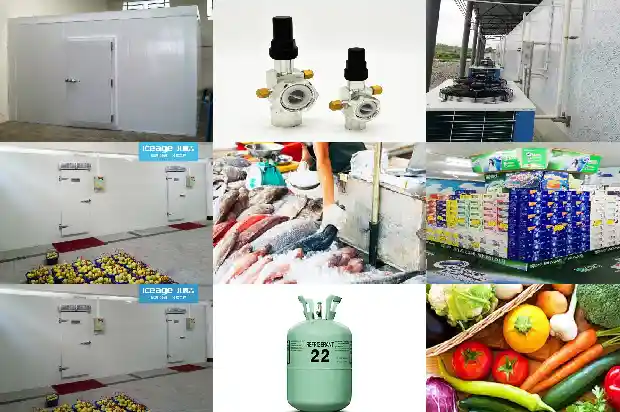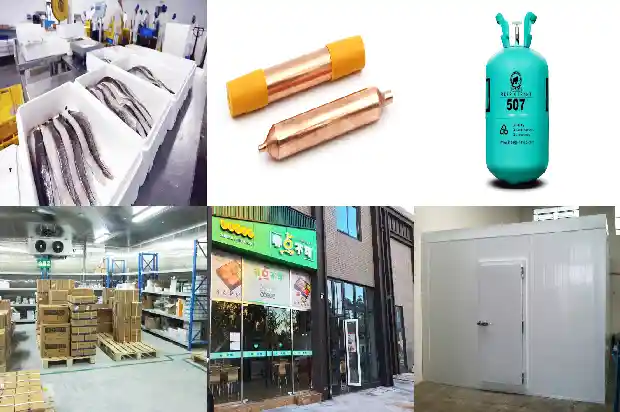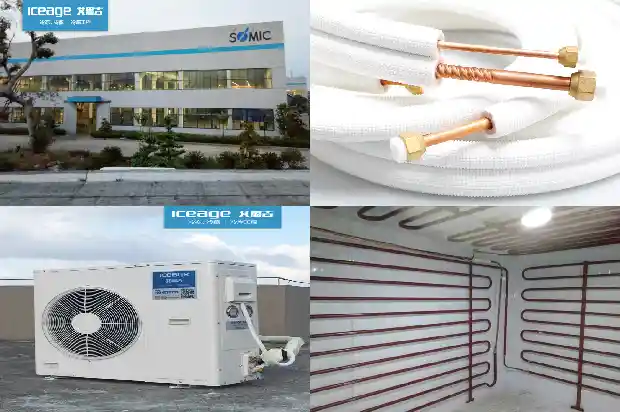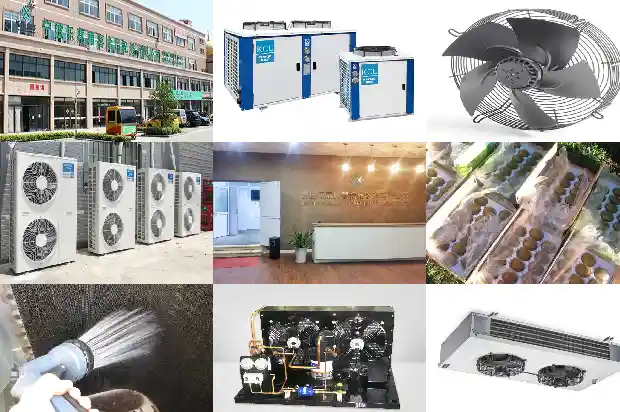The 5 Most Fundamental Problems of Air Conditioning Refrigeration
2025-05-06
General Concepts of HVAC
- HVAC and the "Seven Degrees Space"
(1) "Seven Degrees"
Temperature: Cold and heat;
Humidity: Dryness and wetness;
Freshness: Oxygen and carbon dioxide;
Cleanliness: Dust and VOC, people, the atmosphere, furniture, and the decoration situation;
Speed: Wind speed and the feeling of the wind blowing;
Quietness: Noise and vibration;
Gradient: The uniformity of the temperature field.
Life Safety System (Safety Auxiliary System for Fire Escape Routes)
Smoke Prevention System: Stairwells, ante-chambers, refuge floors, secondary safe zones;
Smoke Exhaust System: Corridors, rooms
Production Safety: Powder, dust, humidity, heat, smoke, toxic and harmful gases;
Special Equipment Environment: IT computer rooms, refrigeration construction.
(2) Air Conditioning:
The Main Tasks of Air Conditioning:
Under the existing natural environment, keep the air in the regulated space at a certain temperature, humidity, flow rate, cleanliness, and freshness.
Four Elements of Air Conditioning: Temperature, humidity, cleanliness, and air distribution are the so-called four elements of air conditioning. By adjusting these four elements, the indoor environment can be controlled to meet the requirements of comfort.
Comfortable Environment: In summer, the generally comfortable temperature for the human body is 24~26°C. In winter, the generally comfortable temperature for the human body is 18~22°C.
Classification of Air Conditioning by Purpose: Comfort type (meeting the human body's requirements for the environment); Process type (meeting the process's requirements for the environment).
Classification of Air Conditioning by Heat Transfer Medium: Water system air conditioning; Refrigerant system air conditioning.
Basic Concepts and Principles of Refrigeration - Three Major Substances:
Air (wind - flowing air)
Freon (refrigerant);
Water - the medium for energy transfer
High-temperature hot water, steam: 90°C, 130°C, 200°C;
Chilled water: 7°C, 12°C; Cooling water: 32°C, 37°C;
Ice (snow and frost): 0°C. - Three Major Power Equipment:
Fan: Drives the air; Water pump: Drives the water circulation; Compressor: Drives the freon.
Diagram of the Energy Exchange Relationship of the Three Major Substances: - Principle of Air Conditioning:
The vapor is sucked into the compressor for compression, increasing the pressure and temperature to the state of superheated vapor; it enters the condenser, releases heat at a constant pressure, and condenses into a liquid; the liquid coming out of the condenser passes through the expansion valve for throttling and pressure reduction, and enters the evaporator in the state of wet vapor, thus completing a cycle. - Working Principle of the Water Machine:
The water system air conditioning is composed of an outdoor main unit and indoor terminal devices. The outdoor main unit provides air conditioning cold/hot water, which is transported to the indoor terminal devices through the water pipe system.
The water and air conduct heat exchange at the indoor terminals to eliminate the cold/heat load of the room. It is an air conditioning system type that centrally generates cold/heat but dispersedly handles the load of each room.
- Working Principle of the Fluorine Machine:
The fluorine system air conditioning uses the refrigerant as the conveying medium and adopts the variable refrigerant flow technology. The outdoor main unit is composed of an outdoor side heat exchanger, a compressor, and other refrigeration accessories, and the indoor unit is composed of a direct evaporative heat exchanger and a fan. One outdoor unit can deliver the refrigerant liquid to several indoor units through the pipeline. By controlling the refrigerant circulation volume of the compressor and the refrigerant flow rate entering each indoor heat exchanger, the indoor cold and heat load requirements can be timely met.
Basic Terms of Refrigeration - Refrigeration:
The process of extracting heat from an object or fluid and discharging the heat into the environmental medium to produce a temperature lower than the environmental temperature.
- Refrigerant:
The working substance that continuously completes the cycle in the refrigeration device. Commonly used refrigerants: R22, R134A, R410A, R32, R290, R404a, R717, water. - Coolant:
It is an intermediate medium used to transfer the cooling capacity in an indirect refrigeration system. Commonly used coolants: water, brine, ethylene glycol aqueous solution. - Refrigeration Capacity:
The amount of heat transferred from a low-temperature object to a high-temperature object by a refrigerator (air conditioner) per unit time. - Heating Capacity:
The amount of heat absorbed from the outside and transported indoors by an air conditioner (heat pump type) per unit time. - COP:
Refrigeration capacity/compressor electrical power. Both the performance coefficient of the heat pump cycle in winter and the energy efficiency ratio of the heat pump in summer are expressed by COP (energy efficiency ratio). - EER:
Refrigeration capacity/total electrical power of the air conditioning system (The higher the EER value, the more heat the evaporation in the air conditioner absorbs or the less electricity the compressor consumes). When cooling in summer, the ratio of the refrigeration capacity (W or Btu/h) to the input power (W) is defined as the energy efficiency ratio EER of the heat pump. - Sensible Heat:
During the process of a substance absorbing or releasing heat, the temperature rises or falls, but the form of the substance does not change. This kind of heat is called sensible heat. - Latent Heat:
During the process of a substance absorbing or releasing heat, its form changes, but the temperature does not change. This kind of heat cannot be measured by a thermometer, and the human body cannot feel it either, but it can be calculated through experiments. This kind of heat is called latent heat. - Refrigeration Ton (RT):
A unit in air conditioning refrigeration. The refrigeration ton is also known as the freezing ton. A freezing ton refers to the energy required to freeze one ton of water into ice. The ability to convert one ton of water at 0 degrees Celsius into ice at 0 degrees Celsius within 24 hours. The freezing ton represents the refrigeration capacity of the refrigerator. - Horsepower (HP):
The calculation of the horsepower (HP) of the air conditioning refrigeration capacity is calculated in kilocalories or watts (W). Generally, 1PH = 2000 kilocalories.
When calculated in international units, it needs to be multiplied by 1.16.
- Unit Conversion:
1 US refrigeration ton = 3024 kilocalories per hour (kcal/h) = 3.517 kilowatts (kW);
1 Japanese refrigeration ton = 3320 kilocalories per hour (kcal/h) = 3.861 kilowatts (kW);
1 horsepower (or 1 horsepower power) = 735.5 watts (W) = 0.7355 kilowatts (kW);
1 kilocalorie per hour (kcal/h) = 1.
163 watts (W);
Celsius temperature °C = (Fahrenheit °F - 32) × 5/9. - Pressure:
It is the force per unit area, represented by P. Its unit is Pascal, abbreviated as Pa; (Kilopascal [kPa] = 1×10³ Pa, Megapascal [MPa] = 1×10⁶ Pa)
Absolute Pressure: The pressure directly acting on the surface of a container or an object.
Gauge Pressure: The pressure measured by a pressure gauge is the gauge pressure.
Basic Components and Composition of Refrigeration Equipment
Refrigeration air conditioning is composed of four major components: ① Compressor; ② Condenser; ③ Throttle valve; ④ Evaporator. - Compressor:
1.1 Positive Displacement Refrigeration Compressor: It compresses the quantitatively inhaled gas periodically by changing the volume of the working chamber. Commonly used positive displacement compressors: Piston type, rolling rotor type, scroll type, single screw type, double screw type.
1.2 Centrifugal Refrigeration Compressor: It continuously compresses the inhaled gas by the action of centrifugal force. - Condenser:
Cools the high-temperature and high-pressure gaseous refrigerant discharged from the refrigeration compressor and liquefies it so that the refrigerant can be recycled in the system. - Throttle Mechanism:
Throttles and reduces the pressure of the high-pressure liquid refrigerant to ensure the pressure difference between the condenser and the evaporator, so that the liquid refrigerant in the evaporator evaporates and absorbs heat under the required low pressure, thus achieving the purpose of refrigeration and cooling; at the same time, it makes the gaseous refrigerant in the condenser release heat and condense under the required high pressure.
In addition, it can adjust the refrigerant flow rate supplied to the evaporator to adapt to the change of the heat load of the evaporator, thus avoiding the situation where part of the refrigerant fails to vaporize in the evaporator. - Evaporator:
Achieves the purpose of refrigeration by the evaporation (boiling) of the refrigerant and the absorption of heat. - Composition of the Air Conditioning System:
Chiller Units: Water-cooled centrifugal (screw type), air-cooled screw type, steam LiBr absorption type, direct-fired LiBr absorption type;
Heat Pump Units: Air-cooled screw type, ground source heat pump, water source heat pump;
Boilers: Hot water boilers, steam boilers, electric boilers (regulatory requirements for heat storage);
Cooling Towers: Open type, closed type, cross-flow, counter-flow;
Water Pumps: Horizontal type, vertical type, end suction, double suction;
Air Conditioning Terminal Equipment: Fan coil units, cabinet air handling units, combined air handling units, cold radiation panels.
Related Articles
- What Are the Common Problems of Oil Return in Compressors?
- The air conditioner is leaking. While waiting for after-sales service, conduct a self-inspection first. Some problems can be handled by yourself
- Solutions to Common Problems in the Installation, Maintenance and Use of Cold Storage
- Countermeasures for Common Problems of Defrosting during Winter Heating of Air-cooled Modules
- Common Problems in the Installation and Maintenance of Cold Storage Systems
- An Experienced Craftsman Summarizes the Common Problems of Cold Storage Equipment, It's Really Comprehensive!
- Eight Quality Problems in HVAC Installation Construction and Corrective Measures
- What Should Be Done When These Problems Occur in the Semi-hermetic Piston Compressor of the Cold Storage?
- Common Problems in After-sales Maintenance of Refrigeration Units
- How to Solve Practical Problems of Air - conditioner Leakage, Noise and Refrigerant Leakage?
- Several Common Problems in the Operation of the Refrigeration System
- HVAC - Solving the 5 Common Problems in the Refrigeration System
- Five Common Problems in the Refrigeration System~~ Solve Them One by One!
- Have You Encountered the Three Common Problems of Refrigeration Compressors?
- Knowledge of Air Conditioning Basics and Refrigeration Principles
- Principles for Setting Air Conditioning Air Outlets and Airflow Organization
- Common Knowledge of Refrigeration and Air Conditioning Systems!
- HVAC (Heating, Ventilation and Air Conditioning) — The Influence of Lubricating Oil on the Refrigeration System
